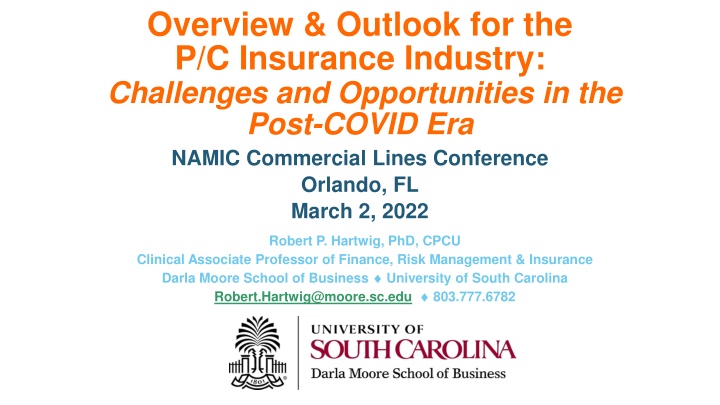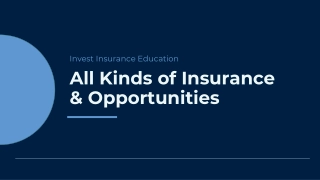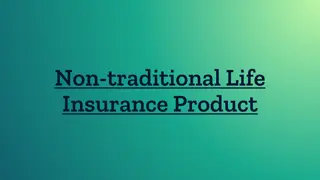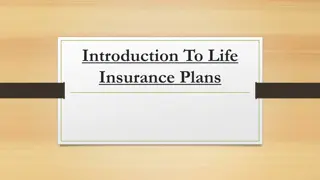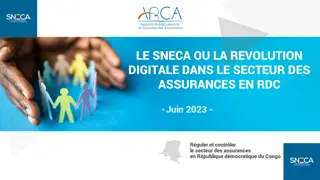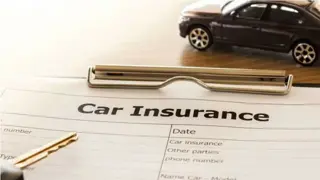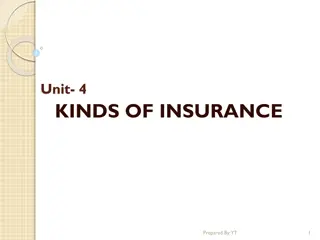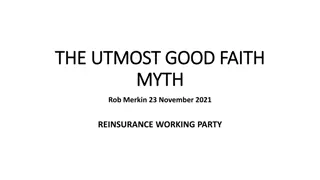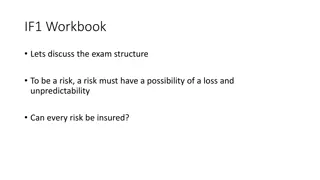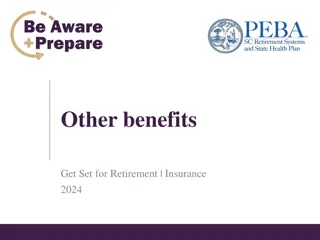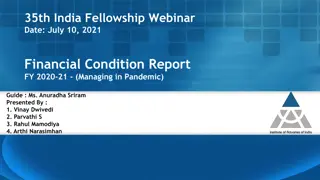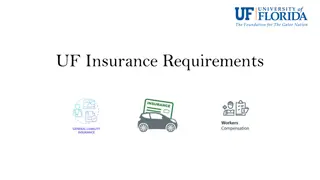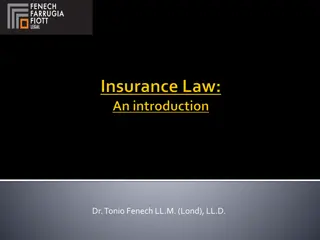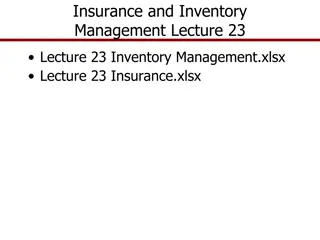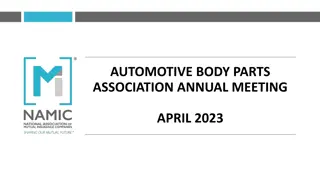Challenges and Opportunities in the Post-COVID Era: P/C Insurance Industry Outlook
Financial overview, profitability trends, and impacts on the Property/Casualty Insurance industry in the wake of COVID-19. Gain insights into industry resilience, profit margins, and future prospects amidst economic uncertainty and global events.
Download Presentation

Please find below an Image/Link to download the presentation.
The content on the website is provided AS IS for your information and personal use only. It may not be sold, licensed, or shared on other websites without obtaining consent from the author.If you encounter any issues during the download, it is possible that the publisher has removed the file from their server.
You are allowed to download the files provided on this website for personal or commercial use, subject to the condition that they are used lawfully. All files are the property of their respective owners.
The content on the website is provided AS IS for your information and personal use only. It may not be sold, licensed, or shared on other websites without obtaining consent from the author.
E N D
Presentation Transcript
Overview & Outlook for the P/C Insurance Industry: Challenges and Opportunities in the Post-COVID Era NAMIC Commercial Lines Conference Orlando, FL March 2, 2022 Robert P. Hartwig, PhD, CPCU Clinical Associate Professor of Finance, Risk Management & Insurance Darla Moore School of Business University of South Carolina Robert.Hartwig@moore.sc.edu 803.777.6782
P/C Insurance Overview & Outlook: Outline P/C Financial Overview & Outlook Amid the COVID-19 Pandemic Catastrophe Loss Trends Capital & Capacity Investment Market Issues: Volatility Rules and a Newly Hawkish Fed The Economy, Insurance and COVID-19: Overview & Outlook Growth, Employment, Inflation Potential P/C Impacts of Russia s Invasion of Ukraine Commercial Lines Overview Distribution Trends Summary and Q&A
P/C Insurance Industry: Financial Overview Amid the COVID-19 Pandemic and Economic Uncertainty The P/C Insurance Industry Entered and Emerged from the COVID-19 Pandemic from a Position of Financial Strength Industry Remains Strong 3 3
Profits and Profitability P/C Profitability Is Extremely Volatile and Consistently Lags the Fortune 500
P/C Industry Net Income After Taxes, 19912021E* 2005 ROE= 9.6% 2006 ROE = 12.7% 2007 ROE = 10.9% 2008 ROE = 0.1% 2009 ROE = 5.0% 2010 ROE = 6.6% 2011 ROAS1 = 3.5% 2012 ROAS1 = 5.9% 2013 ROAS1 = 10.2% 2014 ROAS1 = 8.4% 2015 ROAS = 8.4% 2016 ROAS = 6.2% 2017 ROAS =5.0% 2018 ROAS = 8.0% 2019: ROAS = 7.7% 2020: ROAS = 6.8% 2021: ROAS = 6.0%* $24,404 $ Millions $80,000 $65,777 $63,784 $63,032 $62,496 $61,445 $60,700 $56,826 $56,161 $70,000 $55,870 $60,000 $44,155 $42,924 $38,501 $36,819 $36,813 $50,000 $35,204 $33,522 $30,773 $30,029 $28,672 $40,000 $21,865 $20,598 $20,559 $19,456 $19,316 $30,000 $14,178 $10,870 $20,000 $5,840 COVID s impact on net income in 2020-21 were relatively modest $3,046 $3,043 $10,000 $0 -$6,970 -$10,000 91 92 93 94 95 96 97 98 99 00 01 02 03 04 05 06 07 08 09 10 11 12 13 14 15 16 17 18 19 20 21* *2022 is estimate based on actuals through Q3. ROE figures are GAAP; 1Return on avg. surplus. Excludes Mortgage & Financial Guaranty insurers for years (2009-2014). Sources: A.M. Best, ISO, APCIA.
ROE: Property/Casualty Insurance by Major Event, 1987 2021E* (Percent) P/C Profitability Is Influenced Both by Cyclicality and Volatility 20% Katrina, Rita, Wilma Harvey, Irma, Maria, CA Wildfires Low CATs 15% 2021* 6.0% 10% Sept. 11 Hugo 5% Lowest CAT Losses in 15 Years Sandy 4 Hurricanes 2020 6.8% Covid-19 Andrew, Iniki Financial Crisis* ROE fell by 8.3 pts from 12.7% to 4.4% 0% Record Tornado Losses Northridge -5% 87 88 89 90 91 92 93 94 95 96 97 98 99 00 01 02 03 04 05 06 07 08 09 10 11 12 13 14 15 16 17 18 19 20 21* *Excludes Mortgage & Financial Guarantee in 2008 2014. 2021 figure is estimate based on actual of 6.0% through Q3. Sources: ISO, Fortune, APCIA; USC RUM Center. 6
Rate of Inflation vs. P/C ROE, 19502021* Inflation and P/C ROEs were more highly correlated from the mid-1960s through the 1970s and early 1980s, due in large part to much higher interest rates then and the rise of cash flow underwriting. Interest rates today are rising only modestly and will have marginal impact on P/C ROEs, all else equal (%) 25 1978: 19.0% 20 15 1972: 13.7% 10 2021: 6.0%* 5 0 Inflation Rate ROE (5) 50 52 54 56 58 60 62 64 66 68 70 72 74 76 78 80 82 84 86 88 90 92 94 96 98 00 02 04 06 08 10 12 14 16 18 20 , *2021 ROE based on 9-month data Source: U.S. Bureau of Labor Statistics; ISO; Center for Risk and Uncertainty Management, University of South Carolina.
Capital and Capacity P/C Insurance: Over or Under Capitalized? Is the Industry Creating Economic Value?
Policyholder Surplus (Capacity), 2006:Q4 2020:Q4E and 2021F* ($ Billions) $1,050 Financial Crisis (-16.2%) The P/C insurance industry entered the COVID-19 pandemic from a position of strength and was able to withstand the 9.0% surplus decline in Q1 2020 (far less than during the Financial Crisis). 2020 ended with record surplus. 2021 set another new record, potentially reaching $1 trillion for the first time. $974.8 Drop due to near-record 2011 CAT losses (-4.9%) $1,000 $898.5 $950 $865.1 $847.8 $900 $819.7 $812.2 $802.2 $850 $781.5 $779.5 $771.9 $750.7 $742.1 $800 $717.0 $700.9 $750 $676.3 $662.0 $673.9 $675.2 $674.2 $671.6 $673.7 $653.4 $700 $624.4 $614.0 $607.7 $650 $586.9 $583.5 $566.5 $570.7 $567.8 $559.2 $559.1 $550.3 $544.8 $600 $540.7 $538.6 $530.5 $521.8 $517.9 $515.6 $512.8 $511.5 $505.0 $496.6 $490.8 $550 $487.1 $478.5 $463.0 $455.6 $500 $437.1 $450 $400 06:Q4 07:Q1 07:Q2 07:Q3 07:Q4 08:Q1 08:Q2 08:Q3 08:Q4 09:Q1 09:Q2 09:Q3 09:Q4 10:Q1 10:Q2 10:Q3 10:Q4 11:Q1 11:Q2 11:Q3 11:Q4 12:Q1 12:Q2 12:Q3 12:Q4 13:Q1 13:Q2 13:Q3 13:Q4 14:Q1 14:Q2 14:Q3 14:Q4 15:Q2 15:Q4 16:Q1 16:Q4 17:Q2 17:Q4 18:Q3 18:Q4 19:Q1 19:Q2 19:Q3 19:Q4 20:Q1 20:Q2 20:Q3 20:Q4 2021F Policyholder Surplus is the industry s financial cushion against large insured events, periods of economic stress and financial market volatility. It is also a source of capital to underwrite new risks. 2010: Q1 data includes $22.5B of paid-in capital from a holding company parent for one insurer s investment in a non- insurance business. *2021 figure is actual through Q3. Sources: ISO, A.M .Best; Risk and Uncertainty Management Center, University of South Carolina. 10
Traditional and ILS Reinsurance Capital, 20132021E Overall reinsurance capacity has continue to grow steadily despite the pandemic, large CAT losses ($ Billions) $600 $534 $519 $482 +4.4% $500 94 90 $436 $432 $420 88 $400 $400 $368 $400 87 95 75 60 68 48 $300 +2.8% 441 429 $200 394 345 345 341 340 332 320 $100 $0 13 14 15 16 17 18* 19 20 21E Strong global demand for reinsurance capacity will continue for the foreseeable future Source: Artemis.bm at: https://www.artemis.bm/news/ils-capital-expands-in-2021-but-up-to-5-of-reinsurance-trapped-gc-am-best/; University of South Carolina, Risk and Uncertainty Management Center.
US Property Catastrophe Rate-on-Line Index: 1990 2021* Record CAT activity in the US pressured US reinsurance prices in recent years (+6.0% in 2021, +9.0% in 2020, +2.6% in 2019, +7.5% in 2018) (Percent) 300 Post Katrina, Rita, Wilma period 250 200 150 Post-Ike adjustment 100 Adjustment following record tornado losses in 2011 and Sandy in 2012 Post-Andrew surge 2022 Global RoL +10.8% Post-9/11 Adjustment 50 0 90 91 92 93 94 95 96 97 98 99 00 01 02 03 04 05 06 07 08 09 10 11 12 13 14 15 16 17 18 19 20 21 US Reinsurance Pricing Is Sensitive to CAT Activity and Ultimately Impacts Primary Insurance Pricing, Terms and Conditions. *As of January 1 each year. Source: Guy Carpenter; Artemis.bm accessed at: http://www.artemis.bm/us-property-cat-rate-on-line-index 12
Economic Profit Earned by Avg. Company in 96 Industries ($ Mill) McKinsey: Half of all insurers globally are not earning their cost of capital and half are trading below book value. ($ Mill) All Some of the value lost by (re)insurers is being captured by brokers insurance segments have seen returns decline, except brokers McKinsey: After decades of stable returns, insurance is now a value- destroying industry in which half the players do not earn their cost of equity. ($ Mill) Source: McKinsey Global Insurance Report 2022: https://www.mckinsey.com/industries/financial-services/our-insights/creating-value-finding-focus-global-insurance- report-2022; Risk and Uncertainty Management Center, University of South Carolina. 13
Growth & Underwriting Performance Growth Prospects Are Fairly Strong Given Economically-Driven Exposure Growth and Current Rate Trends
Net Written Premium Growth (All P/C Lines): Annual Change, 1971 2021F 2021F: 9.4%* 2020: 1.8% 2019: 3.6% 2018: 10.8% 2017: 4.6% 2016: 2.7% 2015: 3.5% 2014: 4.2 2013: 4.4% 2012: +4.2% (Percent) 1984-87 1975-78 2000-03 25% Net Written Premiums Fell 0.7% in 2007 (First Decline Since 1943) by 2.0% in 2008, and 4.2% in 2009, the First 3- Year Decline Since 1930-33. 20% 15% Sharp recovery in NWP in 2021 (9%+). Strong economic recovery and favorable rate environment both powering growth. 10% 5% 0% 2020 Outlook Pre-COVID: 3.8% Actual: 1.8%** -5% 71 72 73 74 75 76 77 78 79 80 81 82 83 84 85 86 87 88 89 90 91 92 93 94 95 96 97 98 99 00 01 02 03 04 05 06 07 08 09 10 11 12 13 14 15 16 17 18 19 20 21F * **Pre/Post-COVID-19 forecast from A.M. Best Review & Preview (Feb. 2020, 2021). NOTE: Shaded areas denote hard market periods. Sources: A.M. Best (1971-2013, 2021F), ISO (2014-19); Risk & Uncertainty Management Center, Univ. of South Carolina
Commercial Lines NPW Premium Growth: 1975 2021:Q3 Commercial lines premium growth has been sluggish for years, reflecting weak pricing environment. Commercial lines is prone to far more cyclical volatility that personal lines. 35% Economic Shocks, Inflation: 1976: 22.2% 30% Tort Crisis 1986: 30.5% 25% Post-9/11 2002: 22.4% 20% 2018: +14.4% 1988-2000: Period of inter-cycle stability NPW Growth Post-Hurricane Andrew Bump: 1993: 6.3% 15% 2021:Q3 +14.5% Post Katrina Bump: 2006: 7.7% 10% 5% 2020: +3.2% 0% 2019: +6.7% -5% Recessions: 1982: 1.1% 2016: -1.1% Great Recession: 2009: -9.0% -10% -15% 75 77 79 81 83 85 87 89 91 93 95 97 99 01 03 05 07 09 11 13 15 17 19 21:Q3 Note: Data include state funds beginning in 1998. Source: A.M. Best; ISO; APCIA; Univ. of South Carolina Center for Risk and Uncertainty Management Center.
P/C Insurance Industry Combined Ratio, 20012021F** Pre-COVID 2020 Combined Ratio Est. 99.1 (A.M. Best) Actual = 98 Relatively Low CAT Losses, Reserve Releases As Recently as 2001, Insurers Paid Out Nearly $1.16 for Every $1 in Earned Premiums Higher CAT Losses, Shrinking Reserve Releases, Toll of Soft Market Relatively Low CAT Losses, Reserve Releases Sharply higher CATs are driving large underwriting losses and pricing pressure Heavy Use of Reinsurance Lowered Net Losses 120 Avg. CAT Losses, More Reserve Releases 115.8 COVID-19 has had no discernable net impact on pre-COVID expectations for the combined ratio in 2020; -7.5 pts. due to CATs vs. 4.1 in 2019 (about twice avg.) Lower CAT Losses Cyclical Deterioration Best 110 Combined Ratio Since 1949 (87.6) 107.5 106.5 Sandy Impacts 103.7 102.5 101.1 101.0 101 100.8 100.7 99.2 100.1 99.3 99.0 98.9 98.4 100 96.497.097.8 95.7 92.6 90 01 02 03 04 05 06 07 08 09 10 11 12 13 14 15 16 17 18 19 20 21** *Excludes Mortgage & Financial Guaranty insurers 2008 2014. **2021 is estimate; 9-month actual = 99.5. (Q3 figure was 104.5) Sources: A.M. Best, ISO (2014-2019).
Catastrophe Loss Trends The Rise in CAT Losses Shows No Signs of Easing The 2020s Are Off to an Ominous Beginning
U.S. Inflation-Adjusted Insured CAT Losses: 1980 2021 Harvey, Irma, Maria Ida ($36B) TX Freeze ($15B) Katrina, Rita, Wilma 104 $100 Average for Decade Hurricane Andrew $90 85 WTC 79 $80 Billions, 2018 $ 67 $70 2021 CAT insured CAT losses in the US totaled $85B $60 2000s: $25 B 53 2010s: $35 B 1990s: $15 B $50 40 37 $40 1980s:$5 B 26 $30 $20 $10 $0 20 21* 19 808182838485868788899091929394959697989900010203040506070809101112131415161718 Average Insured Loss per Year for 1980-2020 is $22.2 Billion The 2020s are off to an ominous start with $76B in average annual insured losses Sources: Property Claims Service, a Verisk Analytics business (1980-2019); 2020 and 2021 figures from Munich Re; Insurance Information Institute; University of South Carolina, Risk & Uncertainty Management Center.
Top 21 Most Costly Disasters in U.S. History Katrina Still Ranks #1 (Insured Losses, 2020 Dollars, $ Billions) 11 of the top 20 mostly costly insured events in US history occurred between 2010 and 2021 (inclusive) $54.5 $60 $50 $36.0 $40 $28.7 $27.5 $26.7 $30 $23.1 $21.0 $19.0 $16.8 $15.0 $15.0 $15.0 $20 $12.4 $10.6 $10.2 $10.0 $9.8 $8.8 $8.4 $7.9 $7.5 $10 $0 Rita (2005) Torn./T- Storms (2011) Torn./T- Storms (2011) Hugo (1989) Ivan (2004) Laura (2020) Charley (2004) Michael (2018) Wilma (2005) Camp Fire (2018) Ike (2008) Winter Storm Uri (2021)* Harvey (2017) Irma (2017) Sandy (2012) Maria (2017) Northridge (1994) 9/11 (2001) Andrew (1992) Ida (2021)* Katrina (2005) 17 of the 20 Most Expensive Insurance Events in US History Have Occurred Since 2004 *Estimated (in 2021 dollars) Sources: PCS, RMS, Aon, Karen Clark & Co; USC Center for Risk and Uncertainty Management adjustments to 2020 dollars using the CPI. 20
Paper on Insurability of Pandemic Risk Large scale business continuity risks from pandemics are generally note insurable in the private sector Business continuity risks are largely undiversifiable within private insurance markets and are highly correlated with other risks (e.g., investment risks) Large scale business continuity losses pose a potentially systemic risk to the industry and overall economy Download at: https://www.uscriskcenter.com/wp- content/uploads/2020/05/Uninsurability-of-Pandemic-Risk-White-Paper- Hartwig-APCIA-FINAL-WORD.pdf Import role for government
Potential Impacts of COVID-19 on LOSSES in 2020, by Key Line Line Estimated Loss Impact Workers Compensation $0.2B - $92B (depends on severity of pandemic and presumption determination) Business Interruption & Contingency General Liability* $0.7B to $27B loss across US & Bermuda markets Personal/Comm. Motor $26B - $57B reduction in personal auto and $4.2B - $9.4B commercial (US); $1 - $7B overall reduction in UK Mortgage $0 - $1.7B loss across US & Bermuda markets D&O $0.6 - $4.0 loss across US & Bermuda markets Marine/Aviation/Transport $0.3B-$1.3B reduction (US); $0.6 - $1.1B (UK) *Includes nursing home professional liability. Source: Derived from Willis Towers Watson, Scenario Analysis of COVID-19 Pandemic (Fig.11, 14), May 2020. and other sources; Risk and Uncertainty Management Center, University of South Carolina. APRIL/MAY 2020 ESTIMATES $2B - $22B (US); $1.1B - $13.9B (UK) 22
Investments Investment Performance Is a Key Driver of Insurer Profitability Dove to Hawk: How Will an Aggressive Fed Impact Insurer Portfolios?
Property/Casualty Insurance Industry Investment Income: 2000 2021F ($ Billions) $59.6 $60 $56.2 $54.6 $53.4$52.8 $52.3 $51.2 $49.5 $49.2$48.0$47.3$46.4$47.2$46.6 $48.9 $50 $47.1$47.6 Investment income had just recovered from a decade-long slump. Aggressive Fed actions in response to COVID and recession pushed interest rates lower, adversely impact investment income $39.6 $38.9 $38.7 $40 $37.1$36.7 $30 02 03 04 05 06 07 08 09 10 11 12 13 14 15 16 17 18* 19 20 21F Due to persistently low interest rates, investment income remained below pre-crisis levels for a decade. Lower interest rates during COVID drove investment income down once again. Fed rate hikes in 2022 could reverse this trend. 00 01 *2021 figure is anualized YTD 9M actual figure of $39.564B. 2018-19 figures are distorted by provisions of the TCJA of 2017. Increase reflects such items as dividends from foreign subsidiaries. 1 Investment gains consist primarily of interest and stock dividends. Sources: ISO; University of South Carolina, Center for Risk and Uncertainty Management.
Net Investment Yield on Property/Casualty Insurance Invested Assets, 2007 2021:Q3 (Percent) Investment yields in 2021 were depressed-- down about 200 BP from pre-crisis (and 50- 80BP from pre-COVID) levels. Yields in 2021 were likely to lowest since at least 1960. 5.0 4.64.5 4.6 4.4 4.5 4.2 4.0 3.9 3.73.8 4.0 3.7 3.7 3.4 3.4 3.5 3.3 3.23.1 3.1 3.1 3.0 2.6 2.5 03 04 05 06 07 08 09 10 11 12 13 14 15 16 17 18 19 20 21:Q3 Average: 1960-2019 = 4.9% Low: 2.8% (1961) High: 8.2% (1984/85) The yield on invested assets remains depressed relative to pre-financial crisis and pre-COVID yields. Fed rate hikes in 2022 should begin to slowly lift yields. Sources: NAIC data, sourced from S&P Global Market Intelligence; 2017-19 figures are from ISO. 2020-21 data from the APCIA. Risk and Uncertainty Management Center, Univ. of South Carolina.
S&P 500 Index Returns, 19502022* Inflation is forcing the Fed to tighten, sending the stock market into correction territory in February 2022. Geopolitical tensions are exacerbating Wall Street s worries. Annual Return 60% 50% 40% COVID-19 30% 2021: +26.9% 2020: +16.2% 2019: +28.9% 2018: -6.2% 2017: +19.4 2016: +9.5 20% 10% 0% -10% -20% Tech Bubble Implosion Fed Raises Rates 2022* -9.7% -30% -40% Financial Crisis Energy Crisis -50% 50 52 54 56 58 60 62 64 66 68 70 72 74 76 78 80 82 84 86 88 90 92 94 96 98 00 02 04 06 08 10 12 14 16 18 20 22* , *Through Mar. 1, 2022. Source: NYU Stern School of Business: http://pages.stern.nyu.edu/~adamodar/New_Home_Page/datafile/histretSP.html; Center for Risk and Uncertainty Management, University of South Carolina.
US Treasury Security Yields: A Long Downward Trend, 1990 2022* Fed emergency rate cuts and QE in response to the COVID-19 pandemic pushed rates in 2020 to their levels below those in the financial crisis; Strong economic recovery, inflation, expected Fed rate hikes now pushing up yields 9% Yields on 10-Year US Treasury Notes have been essentially below 5% for more than a decade 8% 7% 6% 10-YR. TREASURY Jan. 2020: 1.76% Jul. 2020: 0.62% Jan. 2022: 1.83% 5% 4% 3% 2% Recession 2-Yr Yield 10-Yr Yield 1% 0% '90'91'92'93'94'95'96'97'98'99'00'01'02'03'04'05'06'07'08'09'10'11'12'13'14'15'16'17'18'19'20'21'22 Since roughly 80% of P/C bond/cash investments are in 10-year or shorter durations, most P/C insurer portfolios will have low-yielding bonds for many years to come. *Monthly, constant maturity, nominal rates, through Jan. 2022. Sources: Federal Reserve Bank at http://www.federalreserve.gov/releases/h15/data.htm. National Bureau of Economic Research (recession dates); Risk and Uncertainty Management Center, University of South Carolina.
Interest Rate Forecasts: 2019 2023F Yield (%) 3-Month Treasury 10-Year Treasury Fed rate hikes will push up yields from 2020 s record lows 3% Persistently low yields have been a challenge for insurers. Fed rate hikes in 2022/23 will boost yields on invested assets 2.33% 2.14% 2.11% 2.09% 1.93% 2% 1.45% 0.95% 0.89% 1% 0.36% 0.04% 0% 19 20 21 22F 23F 19 20 21 22F 23F Short-term rates remain severely depressed with little change expected through 2023 (based on current Fed messaging). Longer-term yields are expected to drift up a bit as the Fed initiates tapering as well modestly higher inflationary expectations Sources: Wells Fargo Securities (2/22); Risk and Uncertainty Management Center, University of South Carolina. 28
The Economy The Strength of the Economy Has Always Influenced Growth in Insurers Exposure Base Across Most Lines Including During the COVID-19 Pandemic The Links Between the Economy and the P/C Insurance Industry Are Strengthening
US Real GDP Growth* 2021:Q4 hit 6.9% on strong consumer spending and inventory rebuilding. For all of 2021, growth was 5.5%, the strongest since 1984. Real GDP Growth (%) Financial Crisis 33.8% 40% 30% 20% 6.9% 6.7% 6.3% 4.5% 4.5% 4.1% 3.6% 2.8% 3.6% 3.8% 3.5% 3.5% 3.1% 3.1% 3.2% 3.2% 3.1% 2.7% 2.7% 2.9% 2.9% 2.5% 2.5% 2.5% 2.4% 2.6% 2.6% 2.2% 2.1% 2.3% 2.3% 2.1% 1.8% 1.8% 1.8% 1.9% 1.6% 1.4% 1.2% 1.1% 1.1% 0.8% 0.7% 10% 0% -1.3% -2.8% COVID CRASH Q2 2020 plunged by 31.2% -10% -5.1% Great Recession began in Dec. 2007 2023: Growth reverts to pre- COVID trend -20% -30% -31.2% -40% 16:1Q 16:2Q 16:3Q 16:4Q 17:1Q 17:2Q 17:3Q 17:4Q 18:1Q 18:2Q 18:3Q 18:4Q 19:1Q 19:2Q 19:3Q 19:4Q 20:1Q 20:2Q 20:3Q 20:4Q 21:1Q 21:2Q 21:3Q 21:4Q 22:1Q 22:2Q 22:3Q 22:4Q 23:1Q 23:2Q 23:3Q 23:4Q 2000 2001 2002 2003 2004 2006 GDP Recovered to Q4 2019 Level in Q1 2021. Demand for Insurance Increasing Materially in 2021/22 Particularly in Economically Sensitive Commercially Lines Such as WC 2005 2007 2008 2009 2010 2011 2012 2013 2014 2015 * Source: US Department of Commerce, Wells Fargo Securities 2/22; Center for Risk and Uncertainty Management, University of South Carolina. Estimates/Forecasts from Wells Fargo Securities.
COVID-19 Stimulus Plans $ Billions To date, Congress has passed 6 COVID-19 relief bills, providing as much as $5.7 trillion in assistance 2,500 $2.2 Trillion $1.9 Trillion 2,000 1,500 $920 Billion 1,000 $483 Billion 500 $225 Billion $8.3 Billion 0 3/6/2020 Coronavirus Preparedness and Response Supplemental Appropriations Act 3/18/2020 3/27/2020 4/24/2020 12/28/2020 3/11/2021 Families First Coronavirus Response Act Health Care Enhancement Act CARES Act Paycheck Protection Program and Consolidated Appropriations Act American Rescue Plan Act
The Economy Drives P/C Insurance Industry Premiums: 2006:Q1 2021:9M* Direct Premium Growth (All P/C Lines) vs. Nominal GDP: Quarterly Y-o-Y Pct. Change 10% DWP y-o-y change y-o-y nominal GDP growth +9.4% +9.8% 8% 6% 4% 2% 0% Premium growth slowed in 2020 due to the COVID recession, but nowhere near as much as the economy overall -2% -4% -6% 2021:9M 2008:Q1 2008:Q3 2009:Q1 2009:Q3 2010:Q1 2010:Q3 2011:Q1 2011:Q3 2012:Q1 2012:Q3 2013:Q1 2013:Q3 2014:Q1 2014:Q3 2015:Q1 2015:Q3 2016:Q1 2016:Q3 2017:Q1 2017:Q3 2018:Q1 2018:Q3 2019:Q1 2019:Q3 2020 Direct written premiums track nominal GDP fairly tightly over time, suggesting the P/C insurance industry s growth prospects inextricably linked to economic performance. *2020 figure is annual. Sources: SNL Financial; U.S. Commerce Dept., Bureau of Economic Analysis; ISO; I.I.I.; Risk and Uncertainty Management Center, University of South Carolina.
US Unemployment Rate Forecast: 2007:Q12023:Q4 Great Recession Rising unemployment eroded payrolls and WC s exposure base. US unemployment rate peaked at 14.8% in April 2020 (13.1% Q2 avg.) 14% 13.1% The Fed considers Full Employment to be 4.1% 13% Unemployment peaked at 10% in late 2009. 12% 11% At 3.5%, the unemployment rate in Feb. 2020 WAS at its lowest point in 50 years. 10.0% 9.7% 9.6% 9.6% 9.6% 9.6% 10% 9.3% 9.1% 9.1% 8.9% 8.8% 8.7% 9% 8.3% 8.2% 8.1% 8.0% 7.8% Return to pre- Covid unemployment rate by late 2022? 7.7% 7.6% 8% 7.3% 7.0% 6.9% 6.8% 6.6% 7% 6.2% 6.2% 6.1% 6.1% 5.9% 5.7% 5.6% 6% 5.4% 5.4% 5.2% 5.1% 5.0% 4.9% 4.9% 4.9% 4.9% 4.8% 4.7% 4.7% 4.6% 4.5% 4.5% 5% 4.4% 4.3% 4.2% 4.1% 4.1% 3.9% 3.9% 3.9% 3.8% 3.8% 3.8% 3.6% 3.6% 3.6% 3.5% 3.5% 4% 3.4% 3.3% 3.3% 3.2% 3.2% 3% 07:Q1 07:Q2 07:Q3 07:Q4 08:Q1 08:Q4 = forecasts ; = actuals Sources: US Bureau of Labor Statistics; Wells Fargo Securities (2/22 edition); Risk and Uncertainty Management Center, University of South Carolina. 08:Q2 08:Q3 09:Q1 09:Q2 09:Q3 09:Q4 10:Q1 10:Q2 10:Q3 10:Q4 11:Q1 11:Q2 11:Q3 11:Q4 12:Q1 12:Q2 12:Q3 12:Q4 13:Q1 13:Q2 13:Q3 13:Q4 14:Q1 14:Q2 14:Q3 14:Q4 15:Q1 15:Q2 15:Q3 15:Q4 16:Q1 16:Q2 16:Q3 16:Q4 17:Q1 17:Q2 17:Q3 17:Q4 18:Q1 18:Q2 18:Q3 18:Q4 19:Q1 19:Q2 19:Q3 19:Q4 20:Q1 20:Q2 20:Q3 20:Q4 21:Q1 21:Q2 21:Q3 21:Q4 22:Q1 22:Q2 22:Q3 22:Q4 23:Q1 23:Q2 23:Q3 23:Q4
Labor Force Participation Rate, Jan. 2002 Jan. 2022* Labor Force Participation as a % of Population Even pre-COVID, labor force participation rates were stubbornly low far below pre-Great Recession levels and one of the country s most vexing labor market problems. COVID-19 has intensified this problem. 68 67 The Great Resignation There are still 1.69M fewer workers in the labor force today than before COVID 66 65 Large numbers of people exited during the Great Recession a trend that continued for years afterward 64 63 Jan. 2022 62.2% 62 61 April 2020 rate fell to 60.2%, its lowest level since 1971 60 '02 '03 '04 '05 '06 '07 '08 '09 '10 '11 '12 '13 '14 '15 '16 '17 '18 '19 '20 '21 '22 *Defined as the percentage of working age persons in the population who are employed or actively seeking work. Note: Recessions indicated by gray shaded columns. Sources: US Bureau of Labor Statistics at http://www.bls.gov/data/; National Bureau of Economic Research (recession dates); Center for Risk and Uncertainty Management, University of South Carolina.
Population Change by State, July 2020July 2021 (U.S.: 0.1%) Top 5 ID MT UT AZ SC 2.9% 1.7% 1.7% 1.4% 1.2% Population growth is a driver of growth insurance demand and insurable exposure. Demographic trends in the Northeast are generally weak Bottom 5 NY IL CA HI LA -1.6% -0.9% -0.7% -0.7% -0.6% Source: U.S. Census Bureau, Dec. 2021 estimates, www.census.gov/popest; Wells Fargo Securities; Risk an Uncertainty Management Center, University of South Carolina.
Auto/Light Truck Sales, 1999-2023F Job growth and improved credit market conditions boosted auto sales to near record levels by 2015/16 (Millions of Units) 19 17.8 17.5 17.4 17.5 17.4 17.4 17.1 17.2 17.1 16.9 17.0 18 16.9 16.6 16.6 16.5 16.4 16.1 17 15.5 15.0 16 14.5 14.4 15 13.2 14 12.7 13 11.6 New vehicle purchases remain restrained by manufacturer supply chain problems 12 New auto/light truck sales fell to the lowest level since the late 1960s. 10.4 11 10 9 99 00 01 02 03 04 05 06 07 08 09 10 11 12 13 14 15 16 17 18 19 20 21 22F 23F Yearly car/light truck sales remain below pre-COVID levels. Auto manufacturer supply chain issues are expected to linger well in to 2022. PP Auto premium might grow by 3.5% - 5%. Source: U.S. Department of Commerce; Wells Fargo Securities (1/22 for 2021-22); Univ. of South Carolina, Center for Risk and Uncertainty Management.. 37
New Private Housing Starts, 1990-2023F Job growth, low inventories of existing homes, low mortgage interest rates and demographics should continue to stimulate new home construction, though materials prices, supply chain problems, lack of labor are headwinds (Millions of Units) 2.1 2.07 1.96 1.85 1.80 1.9 1.71 1.66 1.64 1.62 1.60 1.60 1.58 1.57 1.7 1.48 1.46 1.47 1.38 1.35 1.36 1.5 1.29 1.29 1.26 1.19 1.20 1.20 1.17 1.3 1.11 1.01 1.00 1.1 0.92 0.91 New home starts plunged 72% from 2005- 2009; A net annual decline of 1.49 million units, lowest since records began in 1959 0.78 0.9 0.61 0.59 0.55 0.7 0.5 0.3 90 91 92 93 94 95 96 97 98 99 00 01 02 03 04 05 06 07 08 09 10 11 12 13 14 15 16 17 18 19 20 21 22F23F Insurers Are Continue to See Meaningful Exposure Growth in the Homeowners Line as well as Lines Associated with Home Construction: Construction Risk Exposure, Surety, Commercial Auto; Potent Driver of Workers Comp Exposure Source: U.S. Department of Commerce; Wells Fargo Securities (2/22 for 2021-23); Univ. of South Carolina, Center for Risk and Uncertainty Management.. 38
Private Residential Construction, Jan. 2003 Nov. 2021* ($ Billions, Seasonally Adjusted Annual Rate) The value of Residential Construction has skyrockted during the pandemic and is up ~30% from its pre-COVID peak. Nonresidential Construction is down about 8% relative to pre-COVID levels *Latest available. Sources: US Department of Commerce; Wells Fargo Securities (1/22); Risk and Uncertainty Management Center, University of South Carolina.
INFLATION Claim Inflation Is Here Today Rate and Reserve Adequacy Are Concerns if Current Inflationary Trends Persist 40
U.S. Inflation Rate: 2009-2023F* Inflation accelerated sharply in 2021 accelerating the Fed timetable for rate hikes. Inflation moderate in 2022:H2 and beyond There s a great deal of concern that trillions of dollars of stimulus plus the post-COVID recovery, supply chain disruptions and labor shortages are causing the economy to overheat, resulting in inflation Percentage Change (%) 6.0% 5.5% 4.7% 5.0% 4.0% 3.2% 3.0% 2.4% 2.4% 2.1% 2.1% 1.8% 2.0% 1.6% 1.6% 1.5% 1.3% 1.2% 1.0% 0.1% 0.0% Insurer Concerns About Inflation Rate Inadequacy Reserve Inadequacy -0.4% -1.0% 09 10 11 12 13 14 15 16 17 18 19 20 21F 22F 23F *Annual change in Consumer Price Index for All Urban Consumers (CPI-U). Source: U.S. Bureau of Labor Statistics; Wells Fargo Securities (2/22); USC Center for Risk and Uncertainty Management.
Misery Index: 19482022* Misery Index = (Unemployment Rate) + (Inflation Rate) Index Value 1980: 20.7 25 Unemployment = 7.2% Inflation = 13.5% 1975: 17.6 20 Unemployment = 8.5% Inflation = 9.1% Jan. 2022: 11.5* Unemployment = 4.0% Inflation = 7.5% 2011: 12.0 Unemployment = 8.9% Inflation = 3.1% 15 10 X 5 Most Miserable Decade 1974 1983: 15.9 Unemployment = 7.5% Inflation = 8.4% 2022E = 9.1** Un. = 3.6% Infl. = 5.5% 1974-1983 0 48 50 52 54 56 58 60 62 64 66 68 70 72 74 76 78 80 82 84 86 88 90 92 94 96 98 00 02 04 06 08 10 12 14 16 18 20 22* , *2022 figure is the sum of the January 2022 unemployment rate (4.0%) and the year-over-year-inflation rate for Jan. 2022 vs. Jan. 2021 (7.5%). **Estimated based on Wells Fargo Securities forecasts (2/22). Source: U.S. Bureau of Labor Statistics; Center for Risk and Uncertainty Management, University of South Carolina.
Crude Oil Prices: Price per Barrel, Feb. 2002 Feb. 2022 (Inflation Adjusted) Crude above $100/bbl as of March 1 more than quadruple its pandemic low causing market panic and fueling inflation fears. Feb. 2022: $95.72 Apr. 2020: $20.10 Sources: Macrotrends.net accessed 3/1/22 at: https://www.macrotrends.net/1369/crude-oil-price-history-chart; Risk and Uncertainty Management Center, University of South Carolina.
PPIs for Construction and Construction Employment Construction Employment, Jan. 2001 Nov. 2021* PPIs: Y-o-Y Percent Change, Jan. 2015 Nov. 2021* Construction Employment is reaching a new, all-time record high Overall Materials & Components for Construction were up about 21% in Nov. 2021* *Latest available. Sources: US Department of Commerce; Wells Fargo Securities (1/22); Risk and Uncertainty Management Center, University of South Carolina.
Producer Price Index: Lumber and Wood Products, Jan. 2020 Jan. 2022 Lumber & Wood Product prices surged during the pandemic, peaking in mid-2021 and remain 62% above pre-COVID levels Sources: US Bureau of Labor Statistics; Risk and Uncertainty Management Center, University of South Carolina.
Price Index Changes for Used Cars & Trucks, Jan. 2020 Jan. 2022 New and Used Vehicle prices have surged during the pandemic, +54.6% since Jan. 2020 putting significant pressure on the overall CPI (new and used vehicles account for 7.5% of the index and gasoline 2.8%--auto insurance is 1.6% ) Sources: US Bureau of Labor Statistics; Risk and Uncertainty Management Center, University of South Carolina.
Auto Inflation: Its Not Just a Problem with Chips The US-bound Felicity Ace is ablaze near tha Azores with 4,000 vehicles aboard worth an estimated $400M+ Includes 1,100 Porches, Bentleys, Audis, VWs and Lamborghinis Many of the vehicles are EVs battery fires are believed to be part of the problem Source: Portuguese Navy Blockages of bridges between Canada and the US (esp. the Ambassor Bridge in Windsor, ON) have caused production problems at many US auto plants
Bodily Injury: Severity Trend Is Up, Frequency Plunge in 2020/21 Due to COVID Annual Change, 2005 through 2021* Severity Frequency 20% 14.0% 15% 8.8% 10% 8.0% 7.2% 5.9% 5.7% 5.6% 4.7% 4.4% 3.4% 3.6% 5% 2.9% 3.0% 2.9% 2.1% 2.0% 1.7% 0.0% 1.8% 1.1% 0.0% 0.0% 0.0% 0% -1.1% -1.2% -2.2% -2.2%-3.3% -5% -3.8% -4.0% -4.2% -5.4% COVID pushed frequency down sharply, but severity increased -10% -15% -15.3% -20% -17.9% 2021* 2005 2006 2007 2008 2009 2010 2011 2012 2013 2014 2015 2016 2017 2018 2019 2020 Frequency trend will not return to pre-COVID trajectory until at least 2022 *2021 figure is for the 4 quarters ending 2021:Q3. Source: ISO/PCI Fast Track data; Center for Risk and Uncertainty Management, Univ. of South Carolina. 48
US Personal Auto Claim Frequency Trends Significantly Impacted by COVID but Severities Rise: 12 Months Ending Q3 2021 Year-over-Year Change Frequency Severity 17.7% 20% 14.0% 15% 12.2% 11.9% 10% 6.7% 3.6% 5% 1.6% 0% -5% -10% -10.6% -15% -15.1% -20% -17.9% Bodily Injury Liability Prop. Damage Liability PIP Collision Comprehensive Auto Claims Fell Sharply During the Pandemic, though Claim Severities Rose Materially; Collision/Comp Frequencies Are Now Positive PD Liability claims plunged by nearly 1/4 Source: ISO/PCI Fast Track data for Q3 2021; Risk and Uncertainty Management Center, Univ. of South Carolina. 49
Employment Cost IndexAll Workers 2002:Q1 2021:Q4 The ECI was up 1% in Q4:2021 (down from 1.3% in Q3) and up 4% for all of 2021, the highest 1-year gain based on data going back to 2002. Collectively, the data yet don t suggest a wage- price spiral Sources: US Dept. of Labor; Risk and Uncertainty Management Center, University of South Carolina.
Russian Invasion of Ukraine Potential Impacts on Inflation, Economic Growth and the P/C Insurance Industry 51
Many Potential Implications for P/C Insurers Intensification of Inflationary Pressures Slowdown in US GDP Growth Impacts from Sanctions Increased Threat of Cyber Attacks Increased Financial Market Uncertainty and Volatility Assets Values Change in Timing, Magnitude and Pace of Fed Rate Hikes Global P/C Insurer Impacts
